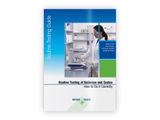To use all functions of this page, please activate cookies in your browser.
my.bionity.com
With an accout for my.bionity.com you can always see everything at a glance – and you can configure your own website and individual newsletter.
- My watch list
- My saved searches
- My saved topics
- My newsletter
BionicsBionics (also known as biomimetics, biognosis, biomimicry, or bionical creativity engineering) is the application of biological methods and systems found in nature to the study and design of engineering systems and modern technology. The word 'bionic' was coined by by Jack E. Steele in 1958, possibly originating from the Greek word "βίον", pronounced "bion", meaning "unit of life" and the suffix -ic, meaning "like" or "in the manner of", hence "like life". Some dictionaries, however, explain the word as being formed from "biology" + "electronics" The transfer of technology between lifeforms and synthetic constructs is desirable because evolutionary pressure typically forces living organisms, including fauna and flora, to become highly optimized and efficient. A classical example is the development of dirt- and water-repellent paint (coating) from the observation that the surface of the lotus flower plant is practically unsticky for anything (the lotus effect). Examples of bionics in engineering include the hulls of boats imitating the thick skin of dolphins; sonar, radar, and medical ultrasound imaging imitating the echolocation of bats. In the field of computer science, the study of bionics has produced artificial neurons, artificial neural networks, and swarm intelligence. Evolutionary computation was also motivated by bionics ideas but it took the idea further by simulating evolution in silico and producing well-optimized solutions that had never appeared in nature. It is estimated by Julian Vincent, professor of biomimetics at the University of Bath in the UK, that "at present there is only a 10% overlap between biology and technology in terms of the mechanisms used". Additional recommended knowledge
HistoryThe name biomimetics was coined by Otto Schmitt in the 1950s. The term bionics was coined by Jack E. Steele in 1958 while working at the Aeronautics Division House at Wright-Patterson Air Force Base in Dayton. However, biomimicry or biomimetics is more preferred in technology world in efforts to avoid confusion between the medical term bionics. MethodsOften, the study of bionics emphasizes implementing a function found in nature rather than just imitating biological structures. For example, in computer science, cybernetics tries to model the feedback and control mechanisms that are inherent in intelligent behavior, while artificial intelligence tries to model the intelligent function regardless of the particular way it can be achieved. The conscious copying of examples and mechanisms from natural organisms and ecologies is a form of applied case-based reasoning, treating nature itself as a database of solutions that already work. Proponents argue that the selective pressure placed on all natural life forms minimizes and removes failures. Although almost all engineering could be said to be a form of biomimicry, the modern origins of this field are usually attributed to Buckminster Fuller and its later codification as a house or field of study to Janine Benyus. Roughly, we can distinguish three biological levels in cool[vague] biology after which technology can be modeled:
Examples of biomimetics
Specific uses of the termIn medicineBionics is a term which refers to flow of ideas from biology to engineering and vice versa. Hence, there are two slightly different points of view regarding the meaning of the word. In medicine, Bionics means the replacement or enhancement of organs or other body parts by mechanical versions. Bionic implants differ from mere prostheses by mimicking the original function very closely, or even surpassing it. Bionics' German equivalent "Bionik" always takes the broader scope in that it tries to develop engineering solutions from biological models. This approach is motivated by the fact that biological solutions will always be optimized by evolutionary forces. While the technologies that make bionic implants possible are still in a very early stage, a few bionic items already exist, the best known being the cochlear implant, a device for deaf people. By 2004 fully functional artificial hearts were developed. Significant further progress is expected to take place with the advent of nanotechnologies. A well known example of a proposed nanodevice is a respirocyte, an artificial red cell, designed (though not built yet) by Robert Freitas. Kwabena Boahen from Ghana was a professor in the Department of Bioengineering at the University of Pennsylvania. During his eight years at Penn, he developed a silicon retina that was able to process images in the same manner as a living retina. He confirmed the results by comparing the electrical signals from his silicon retina to the electrical signals produced by a salamander eye while the two retinas were looking at the same image. PoliticsA political form of biomimcry is bioregional democracy, wherein political borders conform to natural ecoregions rather than human cultures or the outcomes of prior conflicts. Critics of these approaches often argue that ecological selection itself is a poor model of minimizing manufacturing complexity or conflict, and that the free market relies on conscious cooperation, agreement, and standards as much as on efficiency - more analogous to sexual selection. Charles Darwin himself contended that both were balanced in natural selection - although his contemporaries often avoided frank talk about sex, or any suggestion that free market success was based on persuasion, not value. Advocates, especially in the anti-globalization movement, argue that the mating-like processes of standardization, financing and marketing, are already examples of runaway evolution - rendering a system that appeals to the consumer but which is inefficient at use of energy and raw materials. Biomimicry, they argue, is an effective strategy to restore basic efficiency. Biomimicry is also the second principle of Natural Capitalism. Other usesIn a more specific meaning, it is a creativity technique that tries to use biological prototypes to get ideas for engineering solutions. This approach is motivated by the fact that biological organisms and their organs have been well optimized by evolution. Another, more recent meaning of the term "bionics" refers to merging organism and machine. This approach results in a hybrid systems combining biological and engineering parts, which can also be referred as cybernetic organism (cyborg). Practical realisation of this was demonstrated in Kevin Warwick's implant experiments bringing about ultrasound input via his own nervous system. In 2006 Mercedes-Benz introduced its Bionic concept car. See also: implant, prosthesis. See also
Compare with: References
Notes
|
|
| This article is licensed under the GNU Free Documentation License. It uses material from the Wikipedia article "Bionics". A list of authors is available in Wikipedia. |







